|
FAQs about Diatom Algae
Identification
Related Articles: Blue-Green
"Algae"/(Cyanobacteria), Embracing
Biodiversity, Green Algae By Mark E. Evans, Green Algae, Green Algae 2, Avoiding Algae Problems in Marine System,
Algae
Control, Marine Maintenance,
Nutrient Control and Export,
Marine Scavengers, Snails, Hermit
Crabs, Mithrax/Emerald
Green Crabs, Sea Urchins, Blennies, Algae
Filters, Ctenochaetus/Bristle Mouth
Tangs, Zebrasoma/Sailfin Tangs,
Skimmers, Skimmer Selection, Marine Algae, Coralline Algae, Green Algae, Brown
Algae, Diatoms, Brown Algae,
Related FAQs: Controlling: BGA/Cyano, Green Macro-Algae ID 1, Caulerpas, Green
Macro-Algae 1, Green
Macro-Algae 2, Green
Macro-Algae 3, Green Macro-Algae
4, Chlorophyte Behavior,
Chlorophyte
Compatibility/Control, Chlorophyte Selection, Chlorophyte Systems, Chlorophyte Nutrition, Chlorophyte Disease, Chlorophyte Reproduction/Propagation,
Marine Algae ID 1, Marine Algae ID 2, Marine Algae Control FAQs II, Marine Algaecide Use, Nutrient Limitation, Marine Algae Eaters, Culturing Macro-Algae; Red/Encrusting Algae, Green Algae, Brown/Diatom Algae,
|
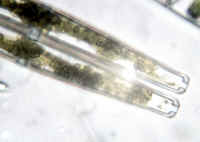 
|
 |
New Print and
eBook on Amazon
Marine Aquarium Algae Control
by Robert (Bob) Fenner
|
|
Dear Bob,
Hope you can help. I have a 600l mixed
reef that is running smoothly apart from what I can only describe
as reef snot! I repeatedly get a covering of this mucus type
stuff on several rocks. I have attached a photo, however it is a
light brown in colour and occasionally forms bubbles. It is
loosely attached and easily syphons out but generally regrows
quite quickly within a couple of days; occasionally it may take a
week to regrow, but always seems to come back. If left, it will
grow into large globules and strings that sometimes detach in the
flow. The problem started a couple of months
back.
Do you have any idea what it is and
how i can get rid of it? I suspect it could be some kind of
bacterial algae?
Some info about my reef if it helps:
It has been running approx 2 years and is a standard Berlin type
system with mature rock. I utilise a good quality protein skimmer
which is slightly oversized and iron based phosphate remover in a
Deltec fluidiser. Flow is moderate to strong using Tunze streams.
Magnesium, calcium and KH are kept in check with balling lite
using Fauna Marin salts apart from KH for which I use standard
bicarb of soda from the local cash and carry (£4 for
3kg!)
Water parameters are good and stable
with nitrate and phosphate being unreadable on Salifert test kit
and a Hanna tester. I've attached a general photo of the tank
for reference.
Many thanks and best
regards,
Ian, by email
|
 |
Ian, I have seen, even personally experienced this sort of light
brown coloured slime issue'¦ and taken a look at bits of
it through my handy dandy Mattel-Intel QX3 microscope. As
far as I can tell, most of the life here is/was
Dinoflagellates'¦ single celled algae with whip-like and
a girdling flagella (for locomotion)'¦ along with
a mix of other algal groups members, Protists'¦
There are a few standard approaches to limiting such growth.
These include nutrient limitation (through good skimming which
you have, use of some chemical filtrants, water changes, gravel
vacuuming, the use of in-place and remoted DSBs/Deep Sand
Beds'¦) and nutrient introduction prevention (rinsing
frozen/defrosted foods, using foodstuffs that are discrete and
completely digestible and palatable so that they're
consumed'¦). Importantly, attention to raised and
sustained RedOx (covered in an article in this issue of UM,
do read this) perhaps through the introduction of Ozone, or other
means e.g., increased pH, above 8.5 during the day, low of
8.3 during the night. All these are activities that favour other
organisms that will out-compete noisome algae for nutrients.
You mention the possibility that this
mass is bacterial algae, likely referring to Cyanobacteria or
Blue-green algae. Both Dinoflagellates and BGA are indeed slimy,
and the latter does occur in several colours, though rarely
brown. Determination of group can be readily determined by
microscopic examination; the BGA being Monerans and like bacteria
lacking nuclei and having but one circular strand of DNA.
You also note the age of the system
and that it is well-established. I encourage you to either add,
or renew some part of your live rock here'¦ this will
add to RedOx, and replenish your likely depauperate mix of life
on and in the rock and substrate. The ecological
improvement will also grant you relief from the brown slime
problem.
The lack of detectable nitrate and
phosphate are telling'¦ these nutrients may be being
taken up by the undesirable biota here, or may be dangerously
limited, otherwise unavailable to your purposeful livestock here.
To put this bluntly, I would be pro-active in reducing, ridding
your system of the brown slime.
|
|
Re: Live rocks turning dark greenish-black now sand
covered by a greenish mat 4/19/10
Greetings ! O great knowledgeable ones,
<Where? They owe me money!>
About a month ago, I had mailed you regarding my rocks turning
blackish green on me. Well now its the sand ! There is this mat
of green algae-like stuff growing on the sand and on the rocks.
It is cobweb like in structure.
Picture attached. Is this BGA ?
<Yep><<Mmm, maybe more Diatoms/Bacillariophyceans.
RMF>>
Grows only in flow deficient places.
<Often the case.>
Should I reduce the photo period ?
<Light is not often the limiting factor for it's growth,
phosphates and nitrates are bigger issues here.>
I employ a 20 gal monthly water change. pls do advice.
<More water changes.>
Also I noticed that there is no mention of Calcinus elegans in
your hermit crab database. Wondering if it helps in the
eradication of BGA.
<Of limited use here. See here and related FAQs for more
http://www.wetwebmedia.com/bluegralgae.htm
>
Thanks Blesson
<Welcome>
<Chris>
|
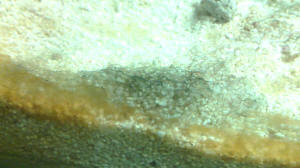 |
|
Re Mandarin hlth., was fat lip, now swollen pooter...
Alpheid ID, Diatoms 3/11/10
Hey Bob,
Thanks for getting back to me so quickly.
The mandarin seems to be acting completely normal but his issue
persists. I wanted to take this time to ask for some guidance on
a few issues I'm having. I believe I told you that I recently
down-sized from a 75 gallon to a red sea max 34 gallon all in
one. I kept about 20 lbs. of live rock from the big tank and
added to it about 25 lbs. of new live rock from the LFS. I also
saved about 2 cups of sand from the big tank and added 20 lbs of
black pacific reef sand to the new setup. I used 2-3 gallons of
water from the big tank and added new RO/DI salt water in the new
set up. Well the tank has been set up for a month now and I am
pulling my hair out dealing with one issue after another. So I
hope you can help with a few things because I'm losing faith
in my ability to maintain my tank. So here is my current set
up:
34 gallon red sea max all in one
20-24 lbs sand
45-50 lbs live rock
I replaced the regular carbon bag from this package with
Chemi-pure elite and also added a bag of Seachem Purigen.
I am also running a Aquaripure nitrate filter.
I change 5-7 gallons of water about every two weeks, replace with
RO/DI salt water and top off with RO/DI fresh water all bought at
the LFS.
Livestock includes:
Mystery wrasse (moved from old set up)
Green mandarin (moved from old set up)
Yellow watchmen goby (added to new set up after 2 weeks)
Scarlet cleaner shrimp (moved from old set up)
pistol shrimp (added to new set up after 2 weeks)
pink tile sea star (added to new set up after 2 days but died
after 2-3 weeks)
orange sun coral polyp frag
green starburst coral frag
green Zo frag
hermits
Astrea, Nassarius, and turbo snails
water parameters:
ph 8.3
nitrate 0-5ppm
nitrite 0
ammonia 0
calcium 420
<Magnesium? I would test for this...>
Alk 14dkh
I feed the fish frozen Mysis and brine shrimp, and blood worms
all soaked in Selcon.
I feed the coral zooplankton or reef chili
I also dose with iodine, purple up, and Seachem liquid buffer as
needed.
Alrighty then, I was wondering what species of pistol shrimp I
picked up.
<... looks like an Alpheus sp., but I don't see it in my
print ref.s or on the Net. There's summat similar on
Keyscritters.com, but I don't see this listed
elsewhere.>
I have been looking around online and have not found any that
look like him. I bought him so that he might pair up with the
goby but this doesn't seem like its going to happen
<And can even be dangerous. See today's "Daily
FAQs">
and even wondered if he might be responsible for the goby's
injury I noticed yesterday.
<Oh yes, could well be>
Secondly, I was hoping you could tell me what caused the sea star
to perish.
<See WWM re... there is little hope for this Fromia>
He was in the new tank for nearly three weeks albeit he
didn't move around too much and suddenly he has a hole in his
disk and what I can only guess were his guts hanging out. And
last, I have this reddish brown stuff growing all over the sand
bed and the glass and a spot or two on the live rock. Is this
Cyanobacteria or what?
<I think "what"... Diatoms likely. Do you have a
microscope?>
I can clean off the glass or stir up a spot in the sand and
within hours its back. I do water changes and as far as I know
keep the water parameters in check so what could be causing this
stuff to grow so fast?
<... again... learn to/use WWM:
http://wetwebmedia.com/dinoalgcontrmar.htm>
Well I'm sure you are tired of reading by now so I will post
some pics for your viewing pleasure and I hope to hear back from
you soon. Thanks again for all that you guys do...
Frank
<Wish I could be of more direct, complete help Frank.
BobF>
|
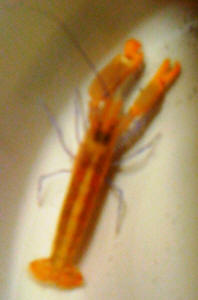 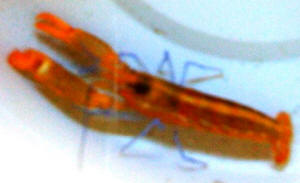
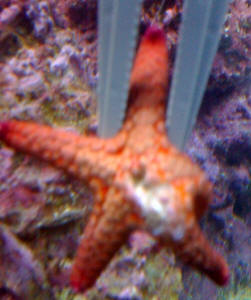 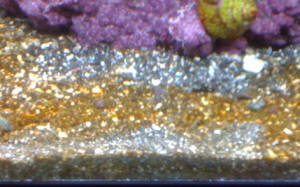 |
|
Brown Algae (Diatoms)? [Yup!] -- 03/03/09 I
am not sure but I do believe my brown algae problem is Diatoms.
<<Yessiree'¦but hardly a 'problem' based
on your pics>> I am attaching pics of my problem...please
feel free to use these pictures as needed on your web site.
<<Thank you>> FYI this is a new tank and is still
cycling. <<So is experiencing the normal/natural algae
succession'¦ (In my best 'Master Po'
voice'¦ 'Ahh, patience Grasshopper')>> I
have read a lot about starting a new tank and am pretty well
convinced this is Diatoms. <<Indeed>> My tank is a
125H (60x18x24) hoping for a reef if I can get past my
intimidation level. <<A time for
reading/research'¦ Do see WWM re>> I am running 2
250w MH lights 12hours a day, 2-1300 gph powerheads cycled for 15
<minutes> alternately, 30g refugium w/ 50/50 pc light on
24/7, 2 cheap skimmers doing pretty well, Plus a homemade O2
fuser that adds O2 through my return pumps about 1 time per hour
flooding the tank with micro bubbles. <<Mmm, do read here
and among the linked files
(http://www.wetwebmedia.com/bubtroubfaqs.htm). Micro-bubbles can
be problematic>> Let me know what your opinion is of my
algae problem. <<Is not a problem'¦ Let your tank
keep cycling as it is'¦and start your research re your
desired biotope to replicate>> Thanks- your site is great
and I find a lot of good reading. <<Me too! >>
-Anthony <<Cheers, Eric Russell>>
|
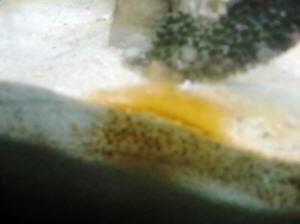 |
Algae ID, Likely Diatoms 1/27/09 Hello crew, <Hi
Mike> I have a 30g tank set up for a month now. For the past week
and a half I have noticed this rust looking algae growing on my live
rock and live sand. It hasn't really been a problem (I can only
assume). Its now spreading all over the in and out takes of my filter
(205 Fluval) and has almost completely covered my power head. I have
looked all over your FAQ's on a bunch of different algae but I
really haven't found one that hits home (sorry I'm more of a
picture type person). The characteristics of it are as follows: On the
sand it looks as if someone dyed it to a rust color, its not hairy or
slimy looking, just a different color. I have 5 Turbos and a sand
sifting star (which eat a lot of it daily). The rock and plastic in the
tank literally look like they're oxidizing, the rock has all
changed color. If I really have stumbled across the right answer then
my assumption would be that its harmless and the bloom will subside
when cycling is done and go away on its own? Now is where my questions
come in. First off could it be that my temperature is too high?
<No.> Its currently 80. I have done a 20% weekly water change and
all my levels are zero. This stuff is growing extremely rapid and im
curious to know if im doing something wrong. If it will subside does
that mean it will go away entirely, if so usually how long after
cycling is complete? <Mike, what you have is a diatom explosion and
is not unusual in new set-ups. Keep up your husbandry and this will
soon go away. See the link here and I'm sure the pics you see will
be similar to what your are seeing in your tank.
http://saltaquarium.about.com/cs/algaecontrol/l/blpicalgaediato.htm>
I forgot to add I currently do not have a protein skimmer (I bought a
cheap one and it makes way too many micro bubbles, everything I have
done to get rid of them ended in disaster so out it went.) would this
have any effect on algae? <On algae, oh yes. An efficient protein
skimmer is one of the best investments you can make to improve water
quality.> Thanks <You're welcome. James (Salty Dog)>
-Mike
Diatoms?: how to proceed 8/23/07 Dear Crew,
<Mark> I know the information is on your web page; I just
can't seem to put it all together. Tank parameters: 90gal set up
for 3 years. Have always seemed to have an algae problem of one kind or
another since automatic fish feeder fell in the tank while I was at
work 1.5 years ago. Water flow is approximately 1500 gph Filtration:
sand and protein skimmer pH 8.2-8.4 NH3=0 NH2=0 Alk=9dKH
NO3=undetectable with Aquarium Pharm. PO3=undetectable with Aquarium
Pharm. Calcium=400ppm 5 gallon water changes weekly Livestock: 4"
yellow tang 3" flame angel 2" cleaner shrimp 2 species of
Montipora 3 species of Acropora 2 species of star polyps 1 frogspawn
colony Three weeks ago I added Kalkwasser to replace evaporation since
my calcium levels were a little low (350ppm vs. the 400ppm as present).
Two days after I added the Kalkwasser I noticed my BGA was replaced by
what I believe to be diatoms (I looked at them with a microscope and
found they were too large to be BGA, but did not appear as symmetrical
as I would expect from diatoms. <Bacillariophyceans are
distinctive... as you state> Cells were oval shaped with only one
plane of symmetry). <Not diatoms. Were organelles, nuclei
apparent?> Also, many of them float to the water's surface
during the day; less or not at all at night. The SPS don't seem to
be affected but the frogspawn and star polyps don't look very good
(stay closed most of the day). <Yikes...> In an effort to rid my
tank of this bloom I replaced my DIY protein skimmer with a Tunze DOC
9005, added an inch of 1-3mm aragonite sand (it was down to 2.5), and
switched from tap water to RO that I buy from the LFS. I also added a
small clump of Chaetomorpha to my tank. <Really? Am assuming you
mean/t the genus Chaetomorpha> What should my next step be? Keep up
with the water changes and wait it out? <Yes, I would... unless the
Stony Corals continue to "look bad"... in which case I'd
effect another, larger water change and use carbon in your filter flow
path> Buy some new live rock and/or order live sand activator to
recharge my system with small detritivores? <Also a good move>
Was this caused by the CaOH precipitating PO3 thus killing the BGA and
leading to a diatom bloom? <Possibly... but not diatoms... some
other Protista> Thanks for a wonderful website, Mark <Do send
along pix if you can. Bob Fenner>
Re: Diatoms?: how to proceed 8/24/07
Hi Bob, <Mark> Thanks for your quick reply. I forgot to mention
that I also stopped adding Kalkwasser a few days ago. As a result the
pH in my tank reverted to pre-Kalkwasser readings: 7.8 in the morning
and 8.2 in the afternoon. Also my calcium increased to 420ppm. This
could be due to experimental error (difference in reading of only one
drop) or due to increase calcium solubility in the lower pH. <Better
to look into bolstering alkalinity slowly through your water changes
over time here...> The corals do look a little better today, but I
am concerned about this Protist bloom. I looked at a sample I took from
the bottom of the tank (first time was from top/dead) and found that
when alive they are very mobile. <NOT Diatoms...> It looks like
they use cilia for locomotion. Also they seem to contain brown
chloroplasts and a nucleus. Enclosed is a Word document with a picture
pasted onto it. Are there any good herbivores for this? <I see...
more likely Dinoflagellates...> I am afraid to buy fresh live rock
at this point because I think it would become smothered. <Mmmm>
Thanks, Mark P.S. I did mean Chaetomorpha (not Chaetomorpa) <Ah,
good. Bob Fenner>
Re: Diatoms?: how to proceed... Maybe
Euglenoids 7/25/07 Hi Bob, Just wanted to thank
you for your help. I did some searching and it looks like these are
Euglenoids from the genus Trachelomonas (though from what I've seen
on the internet this is mostly a freshwater genus). The following link
convinced me; especially the movement.
http://images.google.com/imgres?imgurl=http://silicasecchidisk.conncoll.edu/Pics/Other%2520Algae/Other_jpegs/Trachelomonas1.jpg&imgrefurl=
http://silicasecchidisk.conncoll.edu/LucidKeys/Carolina_Key/html/
Trachelomonas_Main.html&h=235&w=288&sz=38&hl=en&start=27&tbnid=H0z0lEY
Vy3pntM:&tbnh=94&tbnw=115&prev=/images%3Fq%3DEuglenoids%26start%3D20
%26gbv%3D2%26ndsp%3D20%26svnum%3D10%26hl%3Den%26sa%3DN <Okay> So
eventually the alkalinity will improve with water changes? <Mmm,
yes... should... with higher alkalinity in the new water...>
I've had low pH (7.8-8.2) for at least 1.5 years with weekly water
changes. Of course the addition of the Tunze skimmer may take some
pressure off the buffers in the saltwater mix (Instant Ocean). Thanks
again, Mark <I would look into supplemental bolstering of your
alkalinity here... Bob Fenner>
 |
New Print and
eBook on Amazon
Marine Aquarium Algae Control
by Robert (Bob) Fenner
|
|
|

